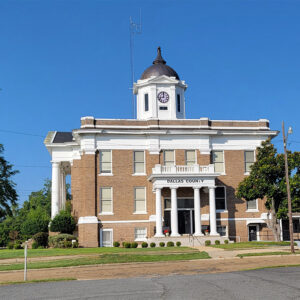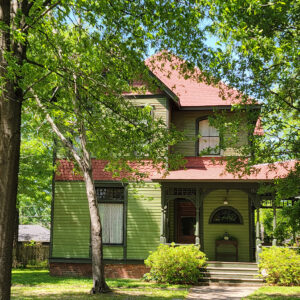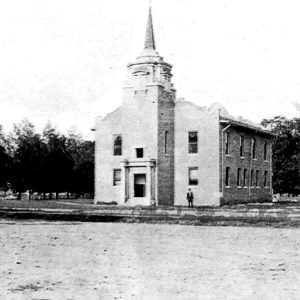calsfoundation@cals.org
Frank Wooster Gibb (1861–1932)
Frank W. Gibb was a prolific architect whose many designs include those of iconic Arkansas county courthouses and a pair of National Historic Landmarks.
Frank Wooster Gibb was born on February 24, 1861, in Rutland, Vermont, to Edward Gibb and Isabella Emerson Gibb. The family moved to Chicago, Illinois, where the elder Gibb established a carriage-furnishings business, then to Little Rock (Pulaski County) in 1871 when the business was destroyed in the great Chicago fire. Frank Gibb graduated from the Missouri School of Mines and Metallurgy (which eventually became the Missouri University of Science and Technology) at Rolla in 1881 and then returned to the Arkansas capital to establish a business as a mining consultant and assayer, becoming a member of the American Institute of Mining Engineers. He also began working as an architect between 1881 and 1887, designing buildings on land his father acquired in what would become the Governor’s Mansion Historic District. He married Mary W. Newton on September 16, 1887; the couple had three children.
He began a formal practice as F. W. Gibb, Architect, in 1890; established a brief partnership with Augustus L. Breysacher in 1893–1894; and had a solo practice until teaming up with George R. Mann from 1900 to 1903 to design a new state penitentiary to replace the one demolished to make room for the new Arkansas State Capitol. He formed Gibb and Sanders, Architects, with Theodore Sanders from 1906 to 1908, and then worked alone as Frank W. Gibb, Architect, for the rest of his life from his offices in the Arkansas Gazette Building in Little Rock.
Gibb’s designs embraced a number of architectural styles, with many of his most noteworthy works, such as the Arkansas State Building, constructed for the 1904 World’s Fair in St. Louis, Missouri, reflecting the Neoclassical style, while other buildings reflected Colonial Revival, Richardsonian Romanesque, and other styles. His body of work included public buildings, commercial structures, churches, hotels, and many residences, such as the Craftsman-style Joseph Taylor Robinson House in Little Rock. He designed dozens of county courthouses in Arkansas, many of which were demolished for public works projects during the Great Depression, and examples of his work could be found throughout the state.
Gibb died at his 1609 Arch Street home on November 4, 1932, after a lengthy illness that left him bedridden for three months. The Arkansas Gazette memorialized him by writing, “Mr. Gibb had wrought well, both as a builder of strong and enduring structures and of strong and enduring friendships. His life was made rich by his personal qualities, by his spirit of fellowship and hospitality.” He is buried at Mount Holly Cemetery in Little Rock.
Two Gibb-designed buildings are National Historic Landmarks, the highest recognition the National Park Service awards to properties outside of the inclusion in the park system. They are the 1911–12 Buckstaff Bathhouse on Bathhouse Row in Hot Springs (listed on the National Register of Historic Places on November 13, 1974, and made a National Historic Landmark on May 28, 1987) and the 1904 Joseph Taylor Robinson House in Little Rock (listed on the National Register on March 28, 1975, and made a National Historic Landmark on October 12, 1994).
Eight Arkansas courthouses that Gibb designed are listed on the National Register of Historic Places: the 1929–30 Conway County Courthouse in Morrilton, the 1903 Bradley County Courthouse in Warren, the 1909 Calhoun County Courthouse in Hampton, the 1911 Dallas County Courthouse in Fordyce, the 1904 Franklin County Courthouse in Ozark, the 1923 Franklin County Courthouse in Charleston, the 1914 Phillips County Courthouse in Helena-West Helena, and the 1914 Yell County Courthouse in Dardanelle.
Other Gibb-designed buildings listed on the National Register are the 1912 Dr. M. C. Hawkins House in Parkdale (Ashley County), the 1902–1904 Masonic Temple in Pine Bluff (Jefferson County), the 1904 William H. Martin House in Hot Springs (Garland County), the 1904 YMCA-Democrat Building in Little Rock, the 1900 First United Methodist Church in Little Rock, the 1925 Healey and Roth Mortuary Building in Little Rock, and the 1900 R. E. Gregory House at Augusta (Woodruff County), in addition to the East Side School in Little Rock’s MacArthur Park Historic District and at least eighteen houses in the Governor’s Mansion Historic District.
For additional information:
“Frank W. Gibb.” Arkansas Gazette, November 6, 1932, p. 4.
“Frank W. Gibb, 71, Called By Death.” Arkansas Gazette, November 5, 1932, p. 4.
Witsell, Charles, and Gordon Wittenberg with Marlyn Jackson Parins. Architects of Little Rock, 1833–1950. Fayetteville: University of Arkansas Press, 2014.
Mark K. Christ
Central Arkansas Library System
 Arts, Culture, and Entertainment
Arts, Culture, and Entertainment Early Twentieth Century, 1901 through 1940
Early Twentieth Century, 1901 through 1940 Historic Preservation
Historic Preservation Dallas County Courthouse
Dallas County Courthouse  Gibb House
Gibb House  Howard County Courthouse
Howard County Courthouse 




Comments
No comments on this entry yet.